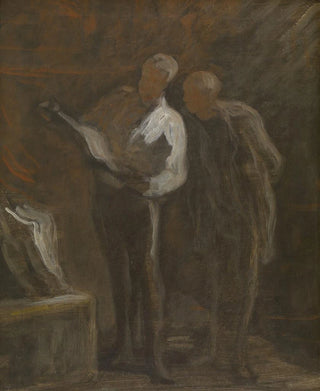Art print | Stamp collectors - Honoré Daumier


View from behind

Frame (optional)
Collectionneurs d'estampes Art print - Honoré Daumier – Engaging Introduction
In the vibrant universe of 19th-century art, Honoré Daumier's "Collectionneurs d'estampes" stands out for its boldness and depth. This iconic piece, capturing the very essence of an era where printmaking intertwined with social critique, immerses us in a world where the perspective on art is both admiring and ironic. Daumier, with his artistic genius, invites us to explore the subtleties of human relationships through the lens of print collection, thus revealing the passions and flaws of his contemporaries. Contemplating this work, the viewer is transported into an atmosphere where art becomes a mirror of society.
Style and uniqueness of the work
The "Collectionneurs d'estampes" piece is characterized by a unique style that combines realism and satire. Daumier, master of observation, manages to capture the features of his characters with striking accuracy, while infusing a caricatural dimension that is full of wit. The faces of the collectors, marked by a certain seriousness, reveal devouring passions for art, but also a form of obsession bordering on the absurd. The composition is carefully orchestrated, with each element occupying a strategic place to reinforce the critical message of the work. The choice of colors, often dark and earthy, accentuates the intensity of emotions and helps create an almost palpable atmosphere. Through this painting, Daumier does not merely depict a scene; he offers a reflection on the very nature of collecting and on the value we assign to art.
The artist and his influence
Honoré Daumier, an emblematic figure of the realist movement, managed to leave his mark on his era through his artistic and social commitment. Beyond his practice of painting and sculpture, he is also renowned for his lithographs that denounce the injustices of his time. Daumier, with his talent, gave a voice to the voiceless and highlighted the flaws of the bourgeoisie. His influence endures today, both in the art world and in critical discourse on society. The themes he

Matte finish

View from behind

Frame (optional)
Collectionneurs d'estampes Art print - Honoré Daumier – Engaging Introduction
In the vibrant universe of 19th-century art, Honoré Daumier's "Collectionneurs d'estampes" stands out for its boldness and depth. This iconic piece, capturing the very essence of an era where printmaking intertwined with social critique, immerses us in a world where the perspective on art is both admiring and ironic. Daumier, with his artistic genius, invites us to explore the subtleties of human relationships through the lens of print collection, thus revealing the passions and flaws of his contemporaries. Contemplating this work, the viewer is transported into an atmosphere where art becomes a mirror of society.
Style and uniqueness of the work
The "Collectionneurs d'estampes" piece is characterized by a unique style that combines realism and satire. Daumier, master of observation, manages to capture the features of his characters with striking accuracy, while infusing a caricatural dimension that is full of wit. The faces of the collectors, marked by a certain seriousness, reveal devouring passions for art, but also a form of obsession bordering on the absurd. The composition is carefully orchestrated, with each element occupying a strategic place to reinforce the critical message of the work. The choice of colors, often dark and earthy, accentuates the intensity of emotions and helps create an almost palpable atmosphere. Through this painting, Daumier does not merely depict a scene; he offers a reflection on the very nature of collecting and on the value we assign to art.
The artist and his influence
Honoré Daumier, an emblematic figure of the realist movement, managed to leave his mark on his era through his artistic and social commitment. Beyond his practice of painting and sculpture, he is also renowned for his lithographs that denounce the injustices of his time. Daumier, with his talent, gave a voice to the voiceless and highlighted the flaws of the bourgeoisie. His influence endures today, both in the art world and in critical discourse on society. The themes he






